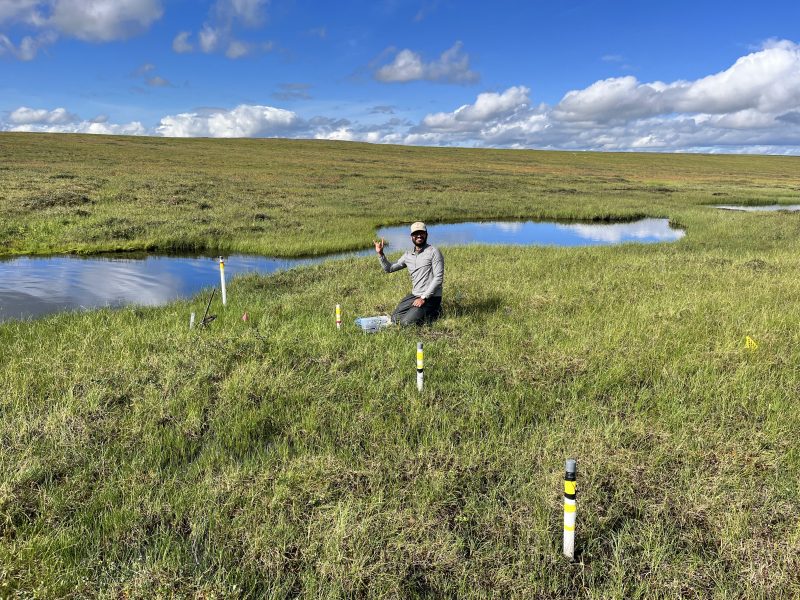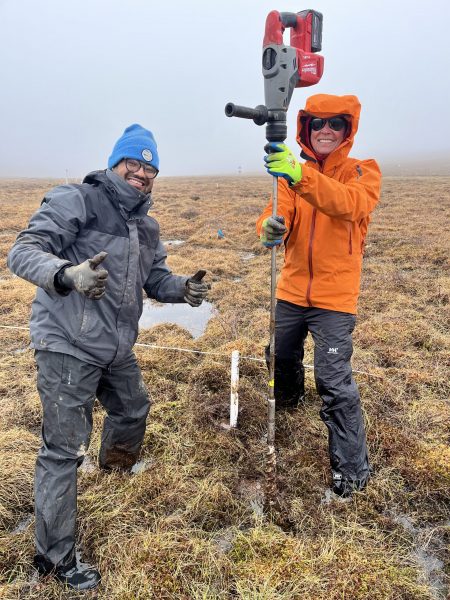Hydrology in the Tundra
December 8, 2024

Permafrost thawing is one of the major threats yet lesser-discussed impacts of climate change. Permafrost covers 24% of the surface of the landmasses in the Northern Hemisphere and accounts for almost half of all the organic carbon stored within the planet’s soil. If this organic carbon remains frozen, it is trapped in the permafrost. However, once thawing accelerates, microbial activity in the soil will increase, resulting in the decay of organic carbon and the release of carbon dioxide and methane into the atmosphere.

The Arctic is warming almost four times faster than the rest of the world, exacerbating the thawing and increasing the risk of permafrost becoming a huge carbon source. However, scientists do not know how the concurrent thawing of permafrost soils and changes in watershed hydrology will affect greenhouse gas emissions. There is a clear need to improve models of cold-region watershed hydrology with extensive field observations to predict how warming and permafrost thaw will affect greenhouse gas releases in the future.
This study is part of a Department of Energy funded project with collaborations from hydrologists and biogeochemists from the University of Michigan, Utah State University, and Oak Ridge National Laboratory. Dr. Bayani Cardenas from The University of Texas at Austin is the principal investigator of this project, and I am the graduate student whose Ph.D. dissertation encapsulates the field and modeling efforts.
Conducting fieldwork in the Arctic is extremely challenging owing to the remote locations and accessibility of the field sites. However, our field efforts are eased with support from the Toolik Field Station (TFS), Institute of Arctic Biology and University of Alaska-Fairbanks.
TFS is located at mile point 284.5 of the Dalton Highway, 370 miles north of Fairbanks (68° 38’ N, 149° 36’ W). During our field trips, we take a 9–12 hour drive from Fairbanks to TFS along the unpaved Dalton Highway. The Dalton Highway was constructed to serve operations at Prudhoe Bay and regular service of the Trans-Alaska pipeline. There is no cell reception on the Dalton Highway, so we always have an InReach and Satellite phone in the truck. CB radios are commonly used by truckers to communicate hazards and other safety information, and it is recommended that all vehicles along the Dalton Highway have a CB radio with them. The trucks are NSF-owned and TFS-operated, running on a set schedule from Fairbanks to TFS every week. However, there are other options, like the Dalton Highway Express, to travel to TFS. TFS covers transportation, housing, food, and lab space for research and field preparation for all researchers.
We prefer planning fieldwork during the summers as the hydrology is dynamic during that time due to the continuous thawing. Our field site is at the Imnavait Creek Watershed. This watershed is a first-order tundra watershed 2.2 sq. km in area and underlain by continuous permafrost. From TFS, our field site is a short 10–15 minute drive north and a ~1-mile picturesque hike along the Imnavait Creek.
My dissertation focuses on subsurface flow above the permafrost (organic carbon rich supra-permafrost aquifer or active layer). For the last few summers, we have installed fully screened groundwater wells along a 2D transect perpendicular to the Imnavait Creek. The motivation behind this installation is to capture groundwater table elevation within the active layer above the permafrost. We have instrumented this transect to get precise and continuous observations of groundwater level, ice table depth, and temperature profiles.
We also measure biogeochemical observations such as dissolved organic carbon, dissolved oxygen, iron, and pH along the transect with depth. We had to take great precautions during field measurements as the tundra landscape is very sensitive, and footprints on the tundra change the topography, thus changing the hydrology. Therefore, in the field, we need to be efficient to ensure minimal disturbance on the tundra, taking as many observations as possible in one go.
These observations will eventually help in numerical model parameterization and validation. We use the multiphysics model Advanced Terrestrial Simulator (ATS) for coupled surface-subsurface thermal hydrology with freezing and thawing, along with PFLOTRAN for reactive transport of DOC (Dissolved Organic Carbon) as water travels through the active layer. This study will help understand how climate variability and warming affect the strong terrestrial-aquatic connection and the hydrologic and biogeochemical processes in terrestrial and aquatic domains.
Neelarun Mukherjee
Doctoral student
